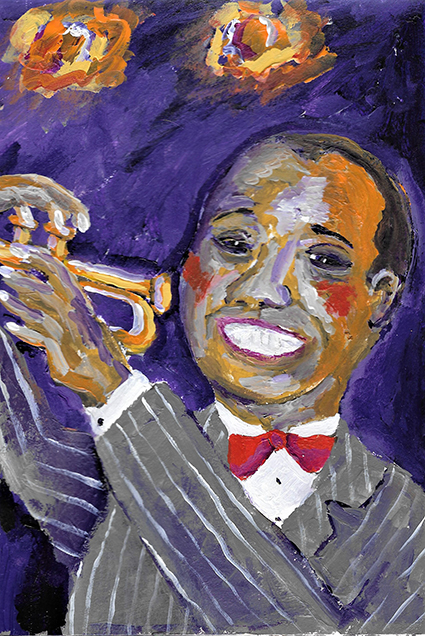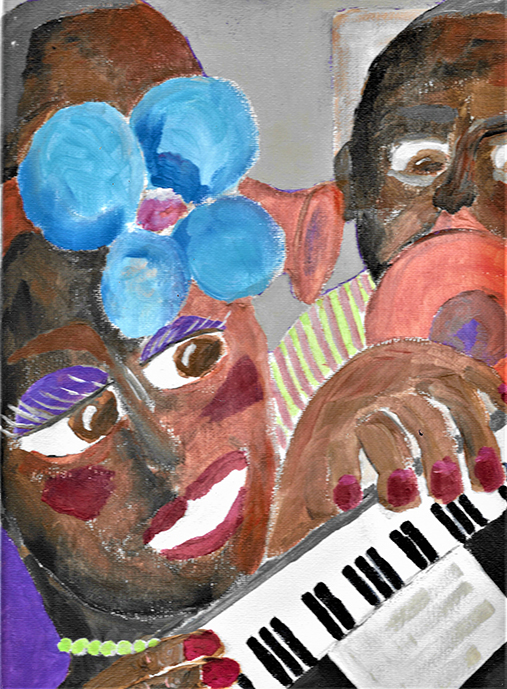Benjamin Goluboff
Louis Armstrong’s Stoicism
“To love only what happens, what was destined. No greater harmony.”
-- Marcus AureliusLouis, who in his later years took consolation
in the Meditations of Marcus Aurelius,
found particular value in the old Stoic’s realism
when he was sued, in 1967,
by his second wife, Lil Hardin,
for copyright to “Struttin’ With Some Barbecue,”
a 1928 composition that Armstrong
still considered to have been a collaboration.She wasn’t suing for the lyrics, either:
that cornball black-face mess
Don Raye stitched up on to the song
like a cheap suit in (Dear God) was it 1941?
No, it was to the changes,
the primary melodic figures,
and the title to which Lil asserted
exclusive proprietary rights.
Her pleadings included the argument
(thirty years since the divorce
and the musician still bristled at this)
that the melody’s ascent to the major seventh
of the tonic chord, while well within
Armstrong’s competency as a soloist,
was beyond his grasp as a composer.Now Armstrong considered the question
of the song’s authorship in a different light.
When Louis thought about where those
good old Hot Five songs came from
what he remembered was the two of them
sitting around, fooling.
Sometimes with Johnny or the Kid,
sometimes just Louis and Lil.
At the piano, on the back steps,
they could knock off three or four in a night:
Lil taking reverb off Louis,
Lil making him raise his game.
-----Meanwhile, in the wider world,
“Struttin’” would march through American music
like Sherman to the sea.
Jimmy Dorsey would record it in 1949,
Marian McPartland in 1956,
Gil Evans and Cannonball Adderly, ‘58,
Don Cheatham, ‘83, Willie Nelson ‘95,
Wynton and Ellis Marsalis 2002.
“Struttin’” would prove to be
inextinguishable.So in giving up the song,
as he chose to do,
settling the 1967 matter out of court,
Louis gave up something of consequence.
Copyright would revert to Lil,
her heirs and assigns,
But it was sad to think of the woman
bringing mine and yours
to what Louis remembered as a party.
And being carried back to those early years
sounded for Armstrong the blue note
of lost time and unrealized possibilities.And it was here, once again,
that the Reverend Aurelius
came to the musician’s rescue.
One’s equanimity in the present moment
is both the only thing that counts
and the only thing we can control.
This the Reverend had taught him,
and Louis was old enough now
(some passions spent)
to learn the lesson.
Only being cool now, not in 1928,
not in a marriage that was no longer a marriage,
or in the ownership of something
that couldn’t be owned.Louis Armstrong (1901 - 1971), American musician and composer, has been the subject of many biographies, most recently Pops by Terry Teachout.
John Quinn Harbors John Butler Yeats
John Butler Yeats, the painter,
left Ireland in 1908, at the age of sixty-nine.
to settle in New York City
where he established a studio
in a West Side rooming house,
and came largely to rely
on the support of John Quinn,
friend of his son, Willie, the poet.Quinn delighted in the old man,
organizing dinners where Yeats
would hold court with the Ashcan painters,
helping him with the rent sometimes,
and engaging him in a long correspondence
on Art and Life and Ireland,
even though they lived just a cab ride apart.Quinn's one concern as the years went by,
as the world turned to war then turned away,
as the flu went through the city,
was that the old man would die in New York,
as it were, on his watch.The Yeats children – Lily most insistently
who kept at her bedside a photograph
of Yeats with Quinn in Central Park
-- wrote their father, begging for his return.
The old man read the letters and re-read them,
carried them around with him
till they turned to pulp in his pockets,
but he never booked passage home.He wrote that he could not return
until he had finished a self-portrait in oils
intended as a gift for their benefactor, Mr. Quinn.
But the painting, like Penelope's shroud,
woven and unwoven, scraped and revised,
stood uncompleted when the old man finally went
-- in his sleep, still in New York, age 83.Quinn did everything he could at the end,
hiring private duty nurses,
bringing two society doctors to the rooming house,
and, when it was over, writing the family
a fifty-page account of their father's last days,
and shipping the portrait to Dublin for Willie.It did not escape Quinn's notice in all this
that the day the painter died in New York,
February third, 1922,
was the day when Sylvia Beach, in Paris,
brought out the first edition of Joyce's Ulysses.John Quinn (1870 - 1924) was a collector of modern art and a patron of modern artists. Ezra Pound called Quinn Maecenas after the wealthy Roman who was patron to Horace and Virgil. Benjamin Reid’s The Man From New York: John Quinn and his Friends won the Pulitzer Prize for Biography in 1969.
On an Al Hirschfeld Cartoon of Gilbert Seldes's and Erik Charell’s Swingin’ the Dream, 1939
The producers never paid Al for it
till he had a lawyer bring an injunction
against the show, and Sheriff's deputies
impounded all the property,
including Armstrong's horn.In the drawing Armstrong and Goodman
stand in profile, raise their instruments,
and blow in precise bicolor phrases:
black fingers on the trumpet's white stops,
the licorice whip, the handkerchief
in Armstrong's off black hand.Goodman is debonair,
his jaw-line exaggerated,
hair combed back precisely,
and Armstrong is a tribal mask
-- Afro-Modernist --
Al's homage, maybe,
to Mr. Aaron Douglas.Above their heads, upon a cloud
that seems to have been summoned
by their blowing, is the Bard himself,
jitterbugging, making jazz hands.
Swingin’ The Dream was a 1939 Broadway musical adaptation of A Midsummer Night’s Dream that featured many of the era’s great performers and musicians. The show closed after 13 performances. Butterfly McQueen played Puck.
The Poet Calls on Dorothea Tanning
Mr. Sandburg, who had served with her father
in the Spanish war, visited Tanning the fall
she was enrolled at the Chicago Academy of Fine Arts,
and lived in a genteel ladies’ rooming house on Wabash Street
that a witty resident once called
the home of fugitive and cloistered virtue.It made a little stir in the home when the poet,
then in his early fame, came down from Evanston
to collect Tanning for a walk in Lincoln Park
and a bag of chestnuts by the Wells Street el.
Tanning knew that to any of the smart Chicago people
passing by, she and Mr. Sandburg must have looked
like characters from a Sinclair Lewis novel,
but believed with the self-assurance of youth
that she carried Galesburg into the Loop
more gracefully than he.There were moments in the visit
when Tanning wondered if Mr. Sandburg
might be thinking of her in that way.
But this was queasy to consider,
and the poet, as always, was so abstracted,
so off-on-his-own-thing,
that you couldn’t ever tell about him.One thing he kept coming back to, however,
was that art school was a fool’s errand,
was, as he put it, for chumps and sissies.
All you’re going to learn, Dottie,
is the thing of the moment,
and who the longhairs want you to hate.
And with the country going into this slump
it’s a shame to be spending
Andreas’s money on that snake oil.Even at twenty Tanning subscribed to the view,
which would serve her well in the future,
that the sound of a man speaking
must be heard as one would wind in the boughs
or rain on the roof:
bracing, or soothing, or sleepy-making,
but not a sound to make you change
your worldview.She saw immediately, however,
that Mr. Sandburg was right about this,
withdrew from the Academy before November,
got a fraction of her tuition refunded,
and received no more formal training after 1930.Dorothea Tanning and the Guardian Angels
Returned to New York, 1976,
from Sedona by way of France,
Tanning was resolved to live
not in memory, but deliberately,
on the Upper West Side,
to resume her friendship with the city
just where they had left off.But the memories were cunning
in asserting themselves,
and the city had changed.
Trash was everywhere;
people talked only of crime
and the price of apartment rental,
and did so in tones that made Tanning believe
a contagion of irony had erupted
in the speech of New Yorkers.
Irony, it seemed to her,
once the special instrument
of artists and outsiders,
like Tinkers’ jargon or hobo signs,
was now universal and automatic
from Bronx to Battery.As for the memories -- this.
Waiting for the IRT one June evening,
Tanning saw a line of five young men
in red berets coming in military lockstep
down the platform.
One of them carried these chopsticks,
sticks-on-a-chain sort of thing --
a weapon. She didn’t know
what to call it.
And just like that,
despite all her intentions,
Tanning was once more
a citizen of the past.The Gestapo officer
who called Max Mademoiselle.
Marcel’s Boite en Valise.
The street in Marseilles they called Little Vilna
because of all the Litvaks who stayed there
waiting for a ship, for funds,
for papers to get out.
The terrible things that had happened to Soutine
because he could not get out.These were Max’s stories,
the stories of dead friends,
and there was some comfort
mixed with the chill
as she brought them to mind.In the days after her encounter on the platform
Tanning would learn more about the Angels,
would revise her impression of them somewhat,
but still considered it a fact of city life
that you couldn’t have uniformed men
marching about in public without inducing
a certain historical dread in older people.
Dorothea Tanning (1910 - 2012) was an American visual artist and writer. She is the author of two memoirs, Birthday and Between Lives. Interviews with the older Tanning are easily found on the internet. She was married to the artist Max Ernst from 1946 to 1976.
Benjamin Goluboff teaches English at Lake Forest College. In addition to some scholarly publications, he has placed imaginative work -- poetry, fiction, and essays -- in many small-press journals, recently Unbroken, Bird’s Thumb, and War Literature and the Arts. He is the author of Ho Chi Minh: A Speculative Life in Verse, and Other Poems (Urban Farmhouse Press, 2017). Some of his work can be read at www.lakeforest.edu/academics/faculty/goluboff/

